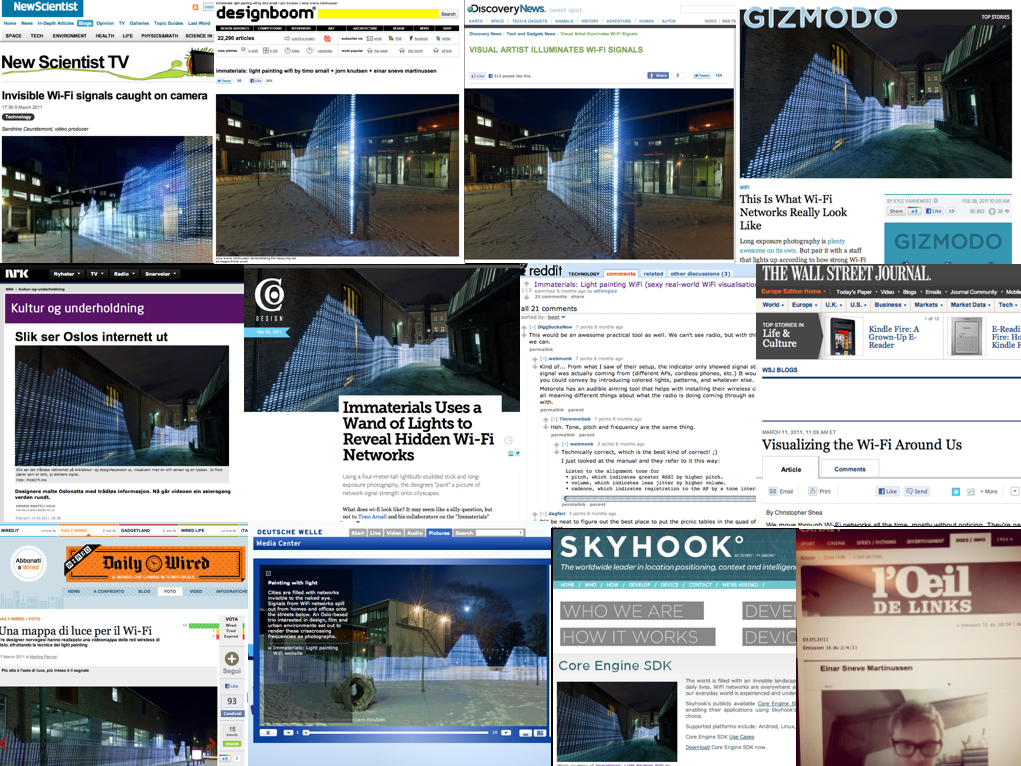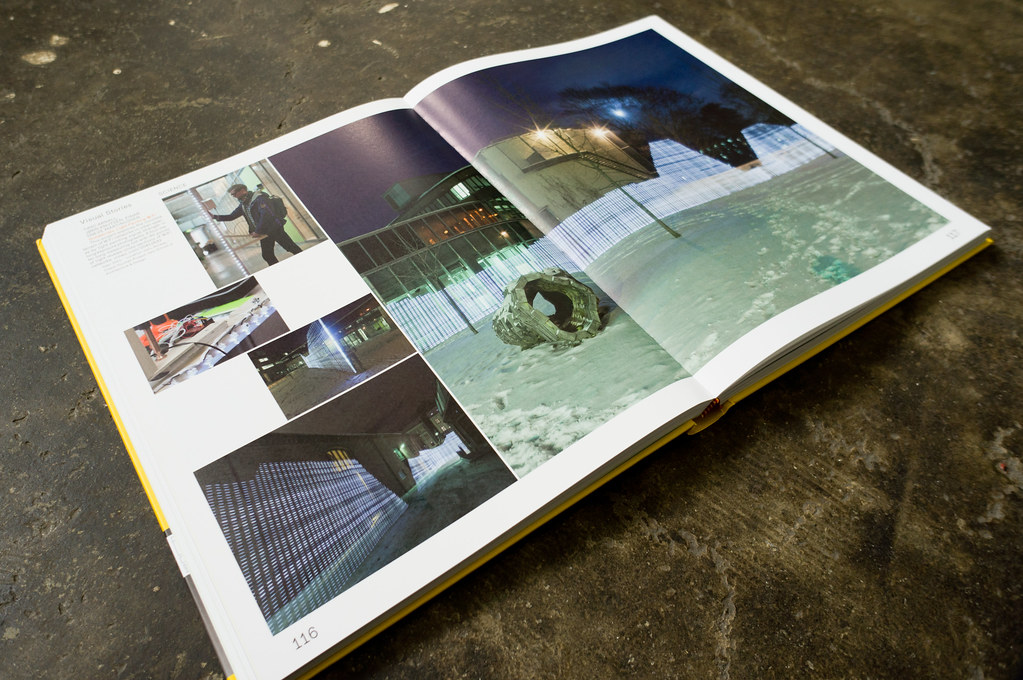|
|
Visualising WiFi for the masses
- Written by Einar Sneve Martinussen
- Friday, 1 June , 2012
A year ago we released our film 'Immaterials: Light painting WiFi'. Since then the film has been viewed over a million times and spread far across the internet, finding its way into many different contexts and taken up in various fields. It has received broad international coverage through traditional news media, design magazines, television, radio, popular science, exhibitions, awards, books, and research. It is still being discussed on blogs, websites and is still being reported and shared on social media. In many ways, the film has become a part of popular culture.
We have been trying to keep track of the propagation of the film for several reasons: to keep a record of media impact, to follow its adventures across both research discourses and popular media, and to see how the concepts and arguments have traveled. The film can be seen as a design proposition directed towards popular culture and by observing its spread we can get a s sense of both how the networked city is understood today and how it may be re-imaginged through design.
It is especially rewarding to see that the project is recognized and discussed within fields that we ourselves inspired by. Information visualization luminary Eward Tufte wrote kindly about our light painting technique:
Absolutely brilliant. And light painting has many obvious extensions and uses. It might be called “light mapping” (which emphasizes the quantitative measurements depicted by the light stick and recorded by the fixed camera) rather than “light painting” (which suggests painting as in brushes and art).
It is also interesting to see how the cultural arguments behind the film get taken up and discussed. Here from Concrete Playground (Brisbane):
The thrall of this project is twofold. One one hand, there is an element of otherworldly beauty; that this spectre that floats around us, through us and in between us at all times, when exposed, is as wonderfully brilliant and delicate in its aesthetic disposition as one could have imagined. On the other hand, the absolute profoundness of the beast (the internet, the world wide web, our global interface) is powerfully shocking.
Acting as a reminder of what drives our society, what facilitates our social flings, our business relations and our personal pursuits, Immaterials shows us the fragility of the foundation of our daily lives — a series of signals that come and go like a tide, largely unnoticed, but necessary for the world to turn the way we want it to.
Unpacking and revealing technological invisibility in daily life is a central aspect of our work and this is also reflected in how it is discussed online. Here from the Creators Project:
Floating amongst the urban landscape is various unseen data like radio waves and WiFi signals. The latter allows for the networked communication that keeps us all so engaged, in touch, and hunched over our screens. But its invisibility means it doesn’t form part of the make up of our cities like a building, a bench, a letterbox or any other apparatus of urbanity. It just hovers there hidden, its importance measured by how quickly a web page loads or a film is downloaded. Its functional design unseen, yet so integral to our lives.
The film was a highly popular across many social media networks, including Facebook and it was on the top technology news item on Digg for 24 hours (14.03.11). The film is also enjoying an ongoing life on Twitter that keeps creating unforeseen spikes in the viewing figures: like when latecomer Tim O’Reilly got to the film a year later than the rest of the internet.
To get an overview of all of these discussions and linkings we have compiled a select list of areas where ‘Immaterials: Light painting WiFi’ has been taken up, as well as some references and an overview of exhibitions, books and talks:
News
NRK, Huffington Post, CNET, Spiegel, Minnesota Public Radio, Deutche Welle, Wall Street Journal, Courrier International, The Atlantic, NRC.nl, El Pais, Il Post, La Figaro, La Repubblica.
Design and art
FRAME, Makezine,Designboom, Infosthetics, Core 77, Fast Co. Design, Kreativt Forum, The Creators Project, Flowing Data, Weave, Stocktown, OK Great, Albitare, Vsual, Dentsu London, Vimeo Staff Picks, Design Playgrounds, Raak, Concrete Playground, Portable.tv, Mother Board, Urban Art Core, Light Sound Dimension, Colossal, Pijamasurf, Digital Art News, We-Make-Money-Not-Art, Creative Applications, Laughing Squid, BERG, Neu Black, Diz Iz Newz, Peta Pixel.
Technology
Wired, O’Reilly Radar, ReadWriteWeb, Engadget, Hack a Day, Wired Italy, Gizmodo, Arduino, Geekbeat.TV, Singularity Hub, PC Mag, Reddit, Postscapes, Utopianist, Adafruit, Slashdot, Slashgear, Fotopia, Dvice, Bit Rebel, Techno Buffalo.
Urbanism and architecture
Arch Daily Brasil, Architect’s Newspaper, The Architecture Report, UrbanNews.fr, Urban and Rural Fabric, Boulevard Numérique.
Popular Science
CBC Spark (radio interview), New Scientist, Discovery, Denver Museum of Nature and Science.
Research
Material World, Space and Culture, ACM Communications, Next Nature.
Other
Warren Ellis , VJ.TV, PSFK, Magical Urbanism, Cluster Mag, Gezduna, Europaconcorsi, Owni, Flavorwire, Make Interesting, The Blaze, likecool.com, Designtagbuch.de, designerblog.it, clickblog.it, Pixel Y Dixel, fstoppers.com, Walyou.
Exhibitions
Lighthouse, Amper&and, Enter5 Biennale (Prague), Night of Art and Science (Groningen).
Talks and lectures
Cognitive Cities (Berlin 27.02.11), IxDA Oslo (Oslo 23.04.11), SVA Interaction Design (New York 18.05.11), Wellington Lux (Wellington 09.07.11), Goldsmiths Design Department, London (27.02.12), Oslo LUX (Oslo 21.02.11), Design of Understanding (St Brides London 27.02.12).
Television
Feature on NRK2’s Nasjonalgalleriet (Norway 21.03.11), interview on lÓeil De Links Canal+ (France 02.05.11).
Books
Visual Storytelling (Gestalten), Invisible Fields (ACTAR), Design Innovation for the Built Environment (Routledge)
The film also got a significant Norwegian media coverage and was used to raise issues about the emergence of networked city and urban development at a national level. The project was featured in several national newspapers and as a part of Dagbladet and Norsk Form’s debate series about the development of Bjørvika: opinion article in Dagbladet, VG (print 25.06.11), Aftenposten (print 12.03.11), Dagens Næringsliv (print 12.03.11).
WiFi is a cultural phenomenon, it is widely known and experienced despite being complex and mostly unseen. Wireless networks are invisible, yet taken-for-granted and are therefore both obscure and mundane at the same time. The popularity of the film and the discussions it have inspired points to how this form of discursive and communicative design research has the potential for explaining, revealing and translating complex technologies within a popular cultural frame and hopefully provoke reflection, discussion and critique (Arnall & Martinussen 2010 [pdf]). Seeing the built environment populated with networks and data offers a new way to understand, and perhaps re-imagine, the networked city (Martinussen 2012).
Update: Following this post we have written a summary of projects inspired by ‘Immaterials: Light painting WiFI’ that shows how the cultural spread of the film have lead to it being taken up by other designers and technologists.
References
Arnall, T & Martinussen, E. 2010. “Depth of field – discursive design research through film”. FORMakademisk, 3 (1): 100-122.
Martinussen, E.S. 2012. “Making material of the networked city.” In Hensel, M, ed. Design Innovation for the Built Environment. London & New York: Routledge, 235-247.
Post a comment
4 Responses to “Visualising WiFi for the masses”
Pingbacks
- El WiFi como arte - Pergamino Raspado on 1 June, 2012 at 21:54
- Voy — Means of production on 26 October, 2012 at 15:49
- YOUrban — Playful 2012 on 26 October, 2012 at 15:50
- Guys Who Create Awesome “Immaterials” Video Track Its Use | Beyond the Beyond | Wired on 5 March, 2014 at 13:02





